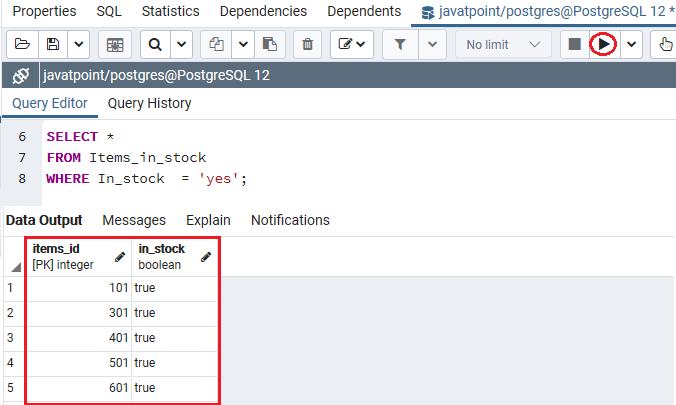
Optional second argument for passing options:* cancel: if true, cancel query if timeout is reached. Useful for complex queries that you want to make sure are not taking too long to execute. The error contains information about the query, bindings, and the timeout that was set. Sets a timeout for the query and will throw a TimeoutError if the timeout is exceeded.
#POSTGRES BOOLEAN CODE#
If you don't want to manually specify the result type, it is recommended to always use the type of last value of the chain and assign result of any future chain continuation to a separate variable (which will have a different type). This code is compatible with PostgreSQL as well as SQL-Server as in SQL Server the boolean TRUE/FALSE is represented by 1/0 respectively while In PostgreSQL, you can use TRUE directly.
#POSTGRES BOOLEAN HOW TO#
In this tutorial, you have learned about the PostgreSQL BOOLEAN datatype and how to use it to store boolean data.Knex ( 'users' ). Likewise, if you want to set a default value for a Boolean column when you create a table, you use the DEFAULT constraint in the column definition as follows: CREATE TABLE boolean_demo( (1 row) Code language: SQL (Structured Query Language) ( sql ) WHERE product_id = 900 Code language: SQL (Structured Query Language) ( sql ) product_id | available VALUES ( 900) Code language: SQL (Structured Query Language) ( sql ) SELECT * If you insert a row without specifying the value for the available column, PostgreSQL uses FALSE: INSERT INTO stock_availability (product_id) If you want to accept 0 and 1 as boolean, your best bet is probably to create the table with the column defined as smallint with a CHECK (colname > 0 AND colname < 1) condition. SET DEFAULT FALSE Code language: SQL (Structured Query Language) ( sql ) To set a default value for an existing Boolean column, you use the SET DEFAULT clause in the ALTER TABLE statement.įor example, the following ALTER TABLE statement sets the default value for the available column in the stock_availability table: ALTER TABLE stock_availability WHERE NOT available Code language: SQL (Structured Query Language) ( sql ) Set a default value of the Boolean column Or you can use the NOT operator to check if values in the Boolean column are false like this: SELECT * (3 rows) Code language: SQL (Structured Query Language) ( sql ) WHERE available = 'no' Code language: SQL (Structured Query Language) ( sql ) product_id | available The following query returns the products that are not available. Similarly, if you want to look for false values, you compare the value of the Boolean column against any valid Boolean constants. WHERE available Code language: SQL (Structured Query Language) ( sql ) For example, the following query returns all products that are available: SELECT * You can imply the true value by using the Boolean column without any operator.

(5 rows) Code language: SQL (Structured Query Language) ( sql ) WHERE available = 'yes' Code language: SQL (Structured Query Language) ( sql ) product_id | available Third, use the following statement to check for the availability of products: SELECT * ( 800, '0') Code language: SQL (Structured Query Language) ( sql )

The datatype input function for type boolean accepts these. INSERT INTO stock_availability (product_id, available) Boolean constants can be represented in SQL queries by the SQL key words TRUE, FALSE, and NULL. We use various literal value for the boolean values. Second, insert some sample data into the stock_availability table.

) Code language: SQL (Structured Query Language) ( sql ) Let’s take a look at some examples of using the PostgreSQL Boolean data type.įirst, create a new table stock_availability to log which products are available. Note that the leading or trailing whitespace does not matter and all the constant values except for true and false must be enclosed in single quotes. The following table shows the valid literal values for TRUE and FALSE in PostgreSQL. However, PostgreSQL is quite flexible when dealing with TRUE and FALSE values. In standard SQL, a Boolean value can be TRUE, FALSE, or NULL. PostgreSQL uses one byte for storing a boolean value in the database. PostgreSQL supports a single Boolean data type: BOOLEAN that can have three values: true, false and NULL.


 0 kommentar(er)
0 kommentar(er)
